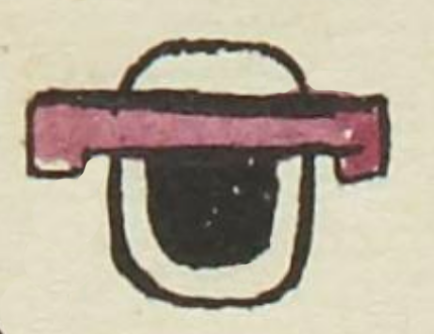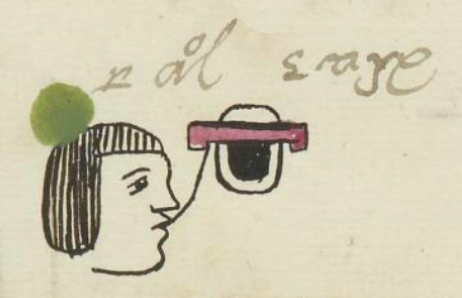Ecaix (MH520r)
This compound glyph for the personal name Ecaix ("Air-Eye," attested here as a man's name), shows a frontal view of a starry or stellar eye with a red upside-down bracket where the red eyelid usually appears. The bracket is horizontal, with short ends at right angles with the bar, and they turn downward. Eye is ixtli. Ecatl is air or breath, but it is often given as the gloss when Ehecatl (the divinity or divine force) is what is indicated visually.
Stephanie Wood
A great many glyphs in this collection start with Eca- when one might expect Eheca-. We are preserving the proclivity of the gloss for Eca-, while also pointing to the likelihood of an unintentional oral abbreviation of Eheca- to Eca-. Ehecatl is a noun in Nahuatl that means wind, and the word was also a proper name for the deity of the wind. In turn this deity was an aspect of the creator (with Quetzalcoatl associations) and with the night. This representation of Ehecatl (which was also a name borne by some humans, given that it was a day sign in the calendar), was apparently how humans saw the deity associated with the wind. The second sun on the Aztec sun stone has a much more elaborate representation of the wind; this epoch was ruled by Quetzalcoatl. The second sun was destroyed by hurricanes and the people were turned into monkeys. For other images of Ehecatl and more information about his shape and that of Quetzalcoatl, see Mexicolore. One of the pre-Columbian statues devoted to the wind gives him a monkey's body but the same buccal mask (with a large point above the mouth or beak) missing in this glyph.
Ecaix is clearly connected with the name Tlamao/Tlamauh, which seems to point to a figure (perhaps divine or a priest) who had a special way of knowing related to seeing. See how the glyphs compare, below. The vocabularies produced by missionaries, such as Alonso de Molina, ascribed to Tlamao a negative assessment of "trickery" or "sorcery," a perspective that might not have been shared by the Nahuas, at least not early on. It seems that a relationship between tlamatini and Tlamao/Tlamauh--and therefore Ecaix, too--should be explored further.
Stephanie Wood
aol ecayx
Alonso Ehecaix
Stephanie Wood
1560
knowledge, knowing, conocimiendo, sabiduría, wind, viento, deities, deidades, nombres de hombres

eca(tl), air or breath, https://nahuatl.wired-humanities.org/content/ecatl
Eheca(tl), divine force of the wind, https://nahuatl.wired-humanities.org/content/Ehecatl
ix(tli), eye or face, https://nahuatl.wired-humanities.org/content/ixtli
ecaichihua, to make a pattern of wind on the face, https://nahuatl.wired-humanities.org/content/ixtliecaichihua
tlamatini, a sage, a wise person, a scholar, https://nahuatl.wired-humanities.org/content/tlamatini
Matrícula de Huexotzinco, folio 520r, World Digital Library.
https://www.loc.gov/resource/gdcwdl.wdl_15282/?sp=119&st=image.
This manuscript is hosted by the Library of Congress and the World Digital Library; used here with the Creative Commons, “Attribution-NonCommercial-ShareAlike 3.0 License” (CC-BY-NC-SAq 3.0).





